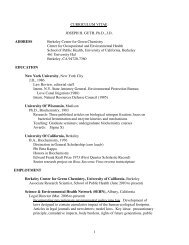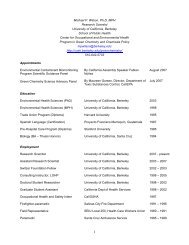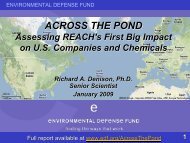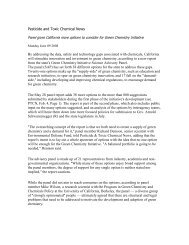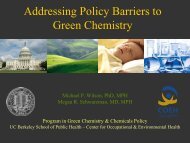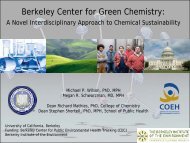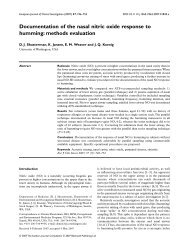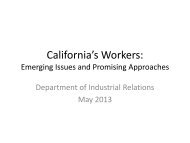Roll-Out of the SIN List 1.0: Observations from the EU
Roll-Out of the SIN List 1.0: Observations from the EU
Roll-Out of the SIN List 1.0: Observations from the EU
Create successful ePaper yourself
Turn your PDF publications into a flip-book with our unique Google optimized e-Paper software.
ROLL-OUT OF THE <strong>SIN</strong> LIST<br />
<strong>1.0</strong>: <strong>Observations</strong> <strong>from</strong> <strong>the</strong> <strong>EU</strong><br />
Caroline Scruggs<br />
Stanford University<br />
<strong>SIN</strong> <strong>List</strong> <strong>1.0</strong> Workshop<br />
San Francisco, California<br />
January 27, 2009
The Challenge <strong>of</strong> Getting<br />
Information<br />
A fruit stand analogy:<br />
So, that’s <strong>the</strong> market for fruit…<br />
and <strong>the</strong> chemicals market is no different.
The Challenge <strong>of</strong> Getting<br />
Information
Current Practices
Sara Lee:<br />
Strategy for Restricting Hazardous Substances<br />
Chemicals management system comprising tens <strong>of</strong> thousands <strong>of</strong><br />
chemicals used in Sara Lee products:<br />
Goals: avoid entry <strong>of</strong> certain substances, phase-out/control o<strong>the</strong>rs
Sara Lee:<br />
Constant Chemicals Vigilance<br />
Sara Lee is not allowed to test its own product ingredients<br />
Dependent on external sources for chemicals safety info<br />
Scientific<br />
Literature<br />
Independent<br />
Testing<br />
Commissions<br />
<strong>EU</strong><br />
Scientific<br />
Committees<br />
O<strong>the</strong>r<br />
Countries<br />
(Prop. 65)<br />
Supplier<br />
Information<br />
NGO &<br />
Regulatory<br />
Developments<br />
Constant monitoring by Safety, Environmental, & Regulatory Affairs<br />
Department (in-house experts)<br />
Filter through information, determine if real problems exist
Sara Lee:<br />
Reactions to & Use <strong>of</strong> <strong>SIN</strong> <strong>List</strong> <strong>1.0</strong>
Sony Ericsson:<br />
Strategy for Restricting Hazardous Substances<br />
Check out www.sonyericsson.com<br />
Make your way to “Conscious design”<br />
Download “list <strong>of</strong> banned and restricted substances”<br />
Download an “environmental declaration” for any Sony Ericsson<br />
phone – link on same page<br />
Goals: avoid entry <strong>of</strong> certain substances, phase-out o<strong>the</strong>rs<br />
Work with suppliers to find safer alternative chemicals<br />
Materials Declaration System: Full disclosure on all components <strong>of</strong><br />
all products by end <strong>of</strong> 2009!
Sony Ericsson:<br />
Ga<strong>the</strong>ring Input <strong>from</strong> Many Sources<br />
Can be difficult getting basic information about material contents<br />
<strong>from</strong> suppliers (<strong>of</strong>ten due to ignorance or misunderstanding)
Sony Ericsson:<br />
Reactions to & Use <strong>of</strong> <strong>SIN</strong> <strong>List</strong> <strong>1.0</strong><br />
<strong>SIN</strong> <strong>List</strong> will be a good reference in <strong>the</strong> future when new chemicals<br />
show up on suppliers’ declarations lists<br />
Have several <strong>SIN</strong> chemicals already on restrictions list<br />
Only <strong>SIN</strong> chemicals used are critical in tiny quantities but have no<br />
known substitutes
Skanska:<br />
Strategy for Restricting Hazardous Substances<br />
Whole company ISO 14001 certified<br />
5 substances globally restricted on all projects (10 soon)<br />
A simple start to:<br />
Get people thinking about chemicals issues and “what more <strong>the</strong>y can do<br />
that is sensible”<br />
Determine extent <strong>of</strong> what can be done at corporate level and what<br />
needs to be done within business units<br />
Ascertain what is transferrable between systems<br />
Individual Business Units have own restricted substance lists and<br />
systems for chemicals management
Skanska:<br />
So What’s in that Brand X Can <strong>of</strong> Paint<br />
Construction industry’s challenge:<br />
<br />
<br />
<br />
<br />
<br />
Deal with materials and brands instead <strong>of</strong> chemicals<br />
Difficult to get full disclosure on products/materials<br />
2 different products same outcome, dramatically different chemistry<br />
No source/database showing composition <strong>of</strong> building materials<br />
Difficult to control every product used on a construction site<br />
How to know what chemicals to look for on a given project What<br />
level <strong>of</strong> control is possible<br />
“We know where we need to get to and we’ve made some baby steps along <strong>the</strong><br />
way- which is more than most companies in our industry have tried to do- but<br />
we’re a long long way <strong>from</strong> having <strong>the</strong> level <strong>of</strong> control where you say, ‘we’re<br />
in control’.”
Skanska:<br />
Reactions to & Use <strong>of</strong> <strong>SIN</strong> <strong>List</strong> <strong>1.0</strong><br />
Learned a lot <strong>from</strong> <strong>the</strong> <strong>SIN</strong> <strong>List</strong>; appreciate its importance as<br />
downstream users<br />
Cannot directly use <strong>SIN</strong> <strong>List</strong>…use materials, NOT chemicals<br />
BUT, substitution concept developing in Skanska<br />
Some business units developing own <strong>SIN</strong>-like lists<br />
Market-by-market, product-by-product approach<br />
Not transferrable – products/brands different in different<br />
markets, as may be substitutes<br />
“It’s <strong>the</strong> start <strong>of</strong> <strong>the</strong> move, long term, towards some<br />
sort <strong>of</strong> global consensus that is relevant to our<br />
industry”
Suggested Next Steps –<br />
<strong>SIN</strong> <strong>List</strong> 2.0
Optimism for <strong>the</strong> Future<br />
“I am personally and pr<strong>of</strong>essionally very very happy about REACH”<br />
A really good solution<br />
Positive changes for downstream users, will make life easier<br />
Will see mentality change within companies, industry maturation<br />
Gradual understanding <strong>of</strong> “new responsibility for chemicals safety<br />
and <strong>the</strong> safety <strong>of</strong> consumers”<br />
Realization <strong>of</strong> “what chemicals management actually is and make it<br />
part <strong>of</strong> <strong>the</strong> way <strong>the</strong>y do business”<br />
REACH is a challenge for industry – success will depend on<br />
cooperation & communication among all stakeholders
Acknowledgements <strong>of</strong> Funding<br />
Stanford University<br />
EPA STAR Award<br />
The research described in this presentation has<br />
been funded in part by <strong>the</strong> U.S. Environmental<br />
Protection Agency (EPA) under <strong>the</strong> Science to<br />
Achieve Results (STAR) Graduate Fellowship<br />
Program. EPA has not <strong>of</strong>ficially endorsed this<br />
presentation and <strong>the</strong> views expressed may not<br />
reflect <strong>the</strong> views <strong>of</strong> <strong>the</strong> EPA.
Thank You!<br />
Contact information:<br />
Caroline Scruggs<br />
Stanford University<br />
Interdisciplinary Graduate Program in Environment & Resources<br />
cscruggs@stanford.edu



